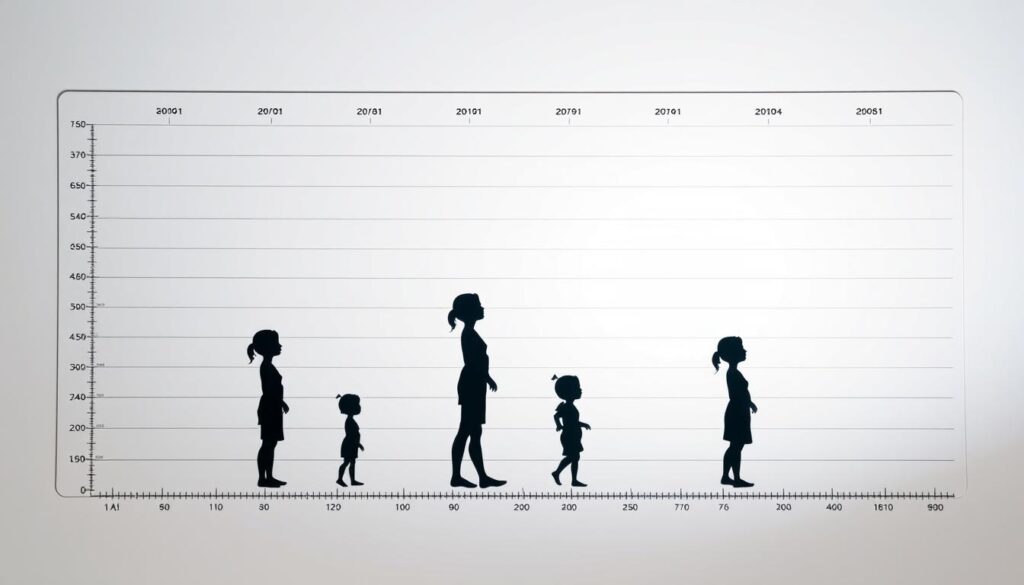Have you ever wondered how professionals spot early signs of developmental changes? A weight and height chart according to age isn’t just lines on paper—it’s a roadmap for understanding lifelong health patterns. These tools track physical progress, offering clues about nutrition, genetics, and overall well-being.
Monitoring body metrics over time helps identify trends that single measurements might miss. For example, consistent tracking can reveal whether a child’s growth aligns with expected milestones or signals a need for deeper evaluation. Age-specific data ensures comparisons stay relevant, since benchmarks shift as years pass.
While charts provide general guidance, they’re not one-size-fits-all. Factors like genetics, environment, and lifestyle play roles too. This article breaks down how to interpret these visuals effectively—and why doing so matters for proactive health management.
Key Takeaways
- Growth charts track patterns, not just individual measurements.
- Age-adjusted data ensures accurate comparisons over time.
- Early detection of outliers can prompt timely health interventions.
- Chapters combine medical standards with real-world variability.
- Regular updates to charts improve reliability of long-term insights.
Introduction to Growth Charts and Healthy Development
Growth charts serve as essential tools for healthcare providers to evaluate physical progress. These visuals map trends over time, offering insights into whether a person’s development aligns with population norms. By tracking metrics like body composition and healthy weight, they help identify potential concerns early.
Importance of Monitoring Growth by Age
Regular check-ups using standardized charts allow comparisons across specific age groups. For children, consistent measurements can reveal patterns that single data points might miss. This helps spot delays or accelerations needing further evaluation.
Medical guidelines emphasize using percentile rankings to assess progress. A child’s position relative to peers highlights whether their weight status or muscle mass falls within typical ranges. Early detection of outliers supports timely interventions for better long-term health.
Overview of Body Composition Metrics
Beyond basic measurements, tools like body mass index (BMI) and body fat analysis provide deeper insights. BMI calculates the ratio of mass to height squared, categorizing individuals into underweight, healthy, or overweight ranges. However, it doesn’t distinguish between muscle and fat.
| Metric | Purpose | Age Group |
|---|---|---|
| BMI | Assess weight categories | 2+ years |
| Body Fat % | Evaluate fat vs. lean tissue | 5+ years |
| Muscle Mass | Track physical strength | All ages |
The CDC recommends combining multiple metrics for a holistic view. Factors like genetics, diet, and activity levels also shape results. This approach ensures personalized care rather than relying solely on generic charts.
Understanding the weight and height chart according to age
What do the lines and numbers on a growth chart really tell us? These visuals plot averages for specific age groups, with vertical axes showing measurements and horizontal axes indicating years. Percentile curves reveal how an individual compares to peers—a 60th percentile mark means 60% of the population falls below that value.
Metrics like body mass index (BMI) integrate both size metrics into a single value. For adults, formulas such as ideal body weight = 50 kg + 2.3 kg per inch over 5 feet offer personalized targets. Pediatric charts adjust these calculations to account for rapid developmental phases.
Obesity thresholds differ by age due to metabolic changes. A BMI of 30+ signals obesity in adults, while children use percentile rankings—values above the 95th percentile indicate similar risks. Muscle mass variations also influence interpretations; athletes might show higher numbers without health concerns.
For example, two 10-year-olds could have identical BMI scores but vastly different body compositions. One might carry excess fat, while the other has dense muscle mass from sports. Context transforms raw data into actionable insights.
Assessing Components of Body Composition
Understanding body composition goes beyond basic measurements—it’s about decoding what makes us unique. Tools like body mass index (BMI) and body fat analysis reveal hidden details about muscle, fat, and overall health. These metrics help tailor strategies for nutrition, fitness, and medical care.
How BMI Simplifies Health Screening
BMI calculates a person’s mass relative to their height squared. The CDC uses it to categorize individuals into underweight, healthy, overweight, or obese ranges. While simple, it’s a starting point—not a final diagnosis. For example, athletes with high muscle mass may show elevated BMI without health risks.
Beyond BMI: The Full Picture
Body fat percentage and muscle distribution add depth to BMI data. A calculator might show two people with identical BMI scores but different body fat levels. Diets rich in protein and regular activity often improve lean tissue ratios, while sedentary habits increase fat storage.
Age and genetics also shape results. Older adults naturally lose muscle, affecting their scores. Tools like skinfold tests or bioelectrical scans offer precise readings. Combining methods provides actionable insights for personalized health plans.
How to Use Charts for Different Age Groups
Interpreting physical development metrics requires distinct approaches for various life stages. Age-specific tools help caregivers spot trends that generic references might overlook. Let’s explore tailored strategies for analyzing data across generations.
Guidelines for Children’s Growth
Pediatric charts rely on percentile rankings rather than fixed numbers. For example, a child at the 75th BMI percentile has higher values than 75% of peers. Track measurements every 3-6 months to identify sustained patterns rather than temporary fluctuations.
Growth spurts and puberty timing create natural variations. Girls often show earlier height increases than boys during adolescence. Consistent monitoring helps distinguish normal shifts from potential health conditions.
| Metric | Children | Adults |
|---|---|---|
| BMI Use | Percentiles | Fixed Categories |
| Muscle-Fat Ratio | Rapid Changes | Gradual Shifts |
| Gender Impact | Post-Puberty | Lifelong |
Adjusting for Adult Maturity and Changes
Adult metrics prioritize maintaining healthy weight ranges over growth tracking. Muscle mass naturally declines after 30, affecting mass index calculations. Women typically carry 10% more body fat than men at similar BMI scores.
Consider activity levels when evaluating numbers. A 40-year-old athlete might weigh more than charts suggest but have optimal fitness. Sudden changes in person weight often signal hormonal shifts or metabolic conditions needing medical review.
Practical tip: Compare measurements against age-gender averages rather than universal standards. Update records annually to account for gradual physiological changes.
Tools and Calculators for Accurate Measurements
Modern health tools turn complex data into actionable insights with just a few clicks. Digital platforms now simplify tracking key metrics like body mass index and ideal body weight, making personalized health management accessible to everyone.
BMI Calculators and Ideal Weight Tools
Online calculators instantly analyze ratios using formulas endorsed by the Centers for Disease Control and Prevention. These tools factor in variables like gender and frame size to estimate healthy ranges. For example:
- Interactive sliders adjust for muscle mass versus fat percentage
- Pediatric versions account for growth spurts
- Senior-focused models consider natural muscle loss
Using Specialized Charts from Trusted Health Sources
Reputable organizations provide standardized visuals that improve measurement accuracy. The CDC’s growth charts, for instance, undergo rigorous testing to reflect population trends. Key advantages include:
- Consistent percentile rankings across demographics
- Regular updates based on new research
- Integration with electronic health records
Combining these resources helps users interpret numbers within clinical guidelines. As noted in a recent analysis, validated tools reduce errors in self-assessment by 42% compared to manual calculations.
Practical Tips for Monitoring Growth and Maintaining Health
Building lasting wellness starts with daily choices that align with your body’s needs. Small, consistent adjustments to routines often yield better results than drastic changes. Let’s explore how to turn data from growth tracking into actionable habits.
Fueling Progress Through Balanced Choices
Prioritize whole foods like vegetables, lean proteins, and whole grains. For children, involve them in meal prep to encourage interest in nutritious options. Limit sugary snacks that spike energy levels but lack lasting benefits.
Adults should watch portion sizes while ensuring adequate protein for muscle maintenance. Swap saturated fats with avocado or nuts to manage body fat levels. Hydration also plays a key role—aim for 8 cups of water daily.
| Focus Area | Children | Adults |
|---|---|---|
| Diet | Colorful plates with varied textures | Protein-rich meals + fiber |
| Activity | 60 mins active play daily | 150 mins weekly cardio |
| Monitoring | Track height every 6 months | Annual BMI checks |
Movement as Medicine
Incorporate activity into routines through family walks or dance sessions. For kids, outdoor games build coordination while burning excess fat. Adults benefit from mixing cardio and strength training to preserve lean mass.
Consistency matters more than intensity. Simple habits like taking stairs or stretching breaks counter sedentary lifestyles. Pair physical efforts with 7-9 hours of sleep to support recovery and health.
Regularly review healthy BMI trends using BMI-based strategies. Early detection of shifts helps address health conditions before they escalate. For children, combine measurements with energy levels and mood observations.
Conclusion
Navigating health metrics requires balancing data with individual context. Trusted tools like detailed height-weight charts and body mass index calculators offer a general guideline—not rigid rules—for tracking progress. Regular checks help spot trends early, whether monitoring a child’s growth curve or an adult’s muscle-to-fat ratio.
These resources empower individuals to understand their unique body composition. Factors like genetics, activity levels, and dietary habits shape results. For example, two people with identical BMI scores might have vastly different fat percentages based on lifestyle choices.
Practical strategies matter most. Pairing nutrient-rich meals with consistent movement supports healthy BMI ranges across life stages. While charts provide direction, personalized advice from healthcare providers ensures tailored solutions for managing potential health conditions.
Remember: numbers tell part of the story. Use them as starting points—not verdicts—for building sustainable wellness habits.




